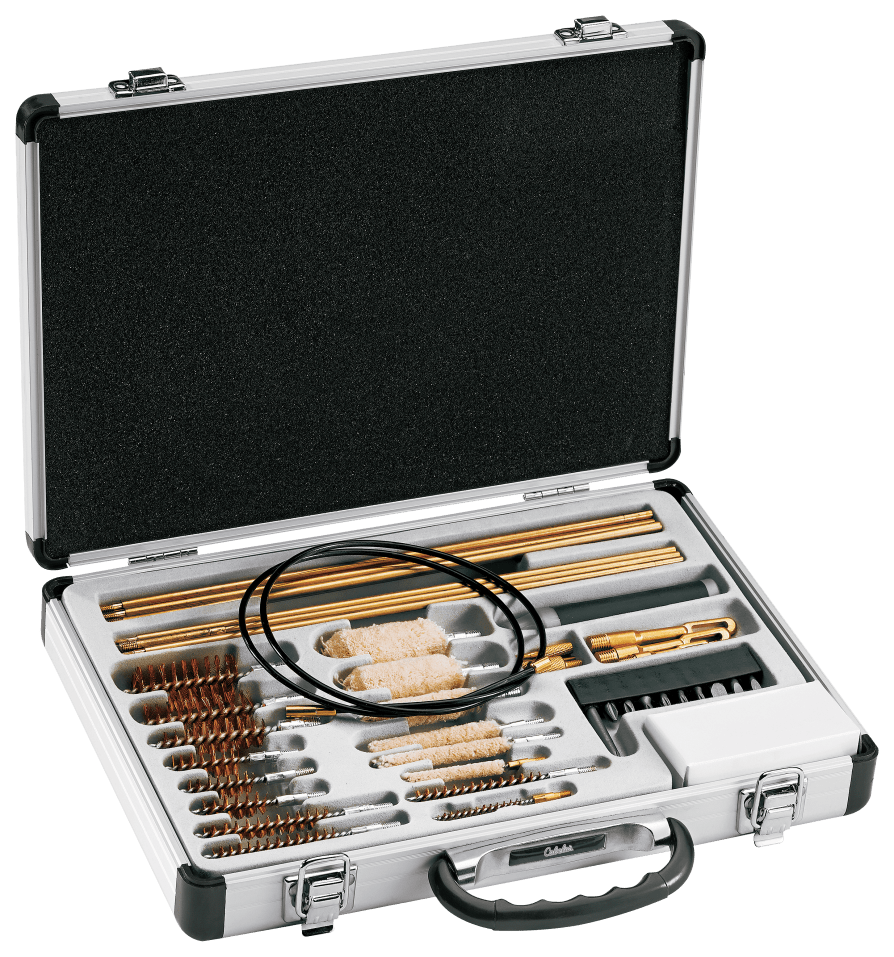
Importance of Regular Gun Cleaning and Barrel Maintenance
Keeping your rifle clean and well-maintained is crucial for several reasons. Regular gun cleaning not only ensures the longevity of your firearm but also contributes to its optimal performance and accuracy. Moreover, it promotes safety and reliability, making it an essential practice for all responsible gun owners. In this article, we will explore different gun cleaning techniques and methods, with a special focus on the significance of barrel cleaning and maintenance.
Gun Cleaning and Refinishing at Bass Pro Shops
Find Gun Cleaning & Refinishing supplies at Bass Pro Shops. Choose between Cleaning Rods, Cleaning Cloths, Cleaning Brushes, and Cleaning Kits.
Shop NowBasic Gun Cleaning Steps
Before diving into specific cleaning methods, it's important to understand the basic steps involved in cleaning a gun. Here is a step-by-step guide to help you get started:
- Start Safe:
Safe firearm handling is ALWAYS the first step, regardless of if you’re cleaning your gun, transporting your gun, storing your gun – safety is key. Always ensure your firearm is unloaded and the magazine removed before starting the cleaning process.
Remember: Treat every firearm as though it were loaded. - Disassembly:
Carefully disassemble your rifle, following the manufacturer's instructions. This will allow you to access all the necessary components for a thorough cleaning. - Remove Debris:
Use a soft brush or a toothbrush to remove any loose debris, dirt, or carbon buildup from the various parts of your firearm. Brush out areas like the action, bolt, receiver, frame, and chamber. Wipe with a cloth or cleaning wipes to remove loose fouling. For the barrel, attach a bore brush to your cleaning rod and apply a small amount of cleaning solvent to the brush. Insert the rod into the barrel and scrub the inside using a back-and-forth motion. This will help break up any fouling or residue. Attach a cleaning patch to the cleaning rod and apply cleaning solvent to it. Push the patch through the barrel, ensuring it contacts the entire surface area. Repeat this process with fresh patches until they come out clean and dry. - Lubrication:
Apply a small amount of gun oil or lubricant to the moving parts of your firearm, ensuring smooth operation and preventing corrosion. Key areas would be bearing surfaces, such as bolt lugs, rails, guides – any metal-on-metal. Avoid using excess oil and do NOT apply any lubricant inside the barrel. Once again, wipe down all components with a clean, dry cloth to remove any residue, dirt, or excess oil that you may have missed in the previous steps. - Reassembly:
Once all the components are clean and lubricated, carefully reassemble your rifle following the manufacturer's instructions. - Function Check:
Before storing your firearm, perform a function check to ensure everything is working properly. This involves testing the trigger, safety mechanism, and slide operation.
Deep Cleaning Techniques
Deep cleaning is necessary for heavily used firearms or those exposed to harsh conditions. This thorough cleaning removes stubborn fouling and ensures optimal performance. Here's how to perform a deep cleaning:
- Disassembly:
Completely disassemble your rifle, separating all components, including the barrel, slide, frame, and small parts. - Cleaning Solvent and Brushes:
Use a suitable cleaning solvent and brushes to thoroughly clean each individual part. Pay special attention to hard-to-reach areas and stubborn fouling. - Ultrasonic Cleaning (Optional):
If you have access to an ultrasonic cleaner and it's suitable for your firearm, consider using it to enhance the deep cleaning process. - Inspection:
While cleaning, inspect each part for any signs of wear or damage. Replace any worn-out or damaged components as necessary. - Lubrication and Reassembly:
Apply an appropriate amount of gun oil or lubricant to the moving parts of your firearm. Reassemble your rifle meticulously, following the manufacturer's instructions.
Choosing the Right Cleaning Solvent and Lubricant
Selecting the appropriate cleaning solvent and lubricant is crucial for effective gun cleaning and maintenance. Consider the following factors when making your choice:
- Compatibility:
Ensure that the cleaning solvent and lubricant are compatible with the materials used in your firearm. Different firearms may require specific products, so refer to the manufacturer's recommendations. - Purpose:
Consider the purpose of the cleaning solvent and lubricant. Some solvents are designed for general cleaning, while others target specific types of fouling or residue. Lubricants should provide adequate protection against wear and corrosion. - Safety:
Choose solvents and lubricants that are safe to use and handle. Consider any potential health hazards and follow the manufacturer's safety instructions.
Tips for Effective Gun Cleaning and Barrel Maintenance
To ensure the best results and maintain the longevity of your firearm, follow these important tips:
- Establish a Cleaning Routine:
Regularly clean and maintain your firearm according to a set schedule. This will help prevent excessive fouling and ensure optimal performance. - Avoid Over-Cleaning:
While it's important to keep your firearm clean, excessive cleaning can lead to unnecessary wear and tear. Clean your firearm as needed, but avoid overdoing it. - Store Properly:
After cleaning, store your firearm in a secure and dry location. Consider using a gun safe or locking case to prevent unauthorized access and protect it from dust, moisture, and other potential damage. - Seek Professional Help if Needed:
If you're unsure about any aspect of gun cleaning or encounter any issues, don't hesitate to seek assistance from a qualified gunsmith or firearm expert.
Proper gun cleaning and barrel maintenance are essential for the longevity, performance, and safety of your firearm. By following the appropriate cleaning techniques, utilizing the right tools and products, and adhering to a regular maintenance routine, you can ensure that your rifle remains in optimal condition.
- 2611 views


